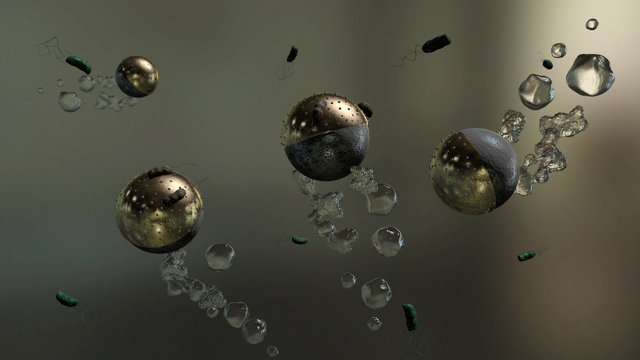Swimming microbots can remove pathogenic bacteria from water

The lack of clean water in many areas around the world is a persistent, major public health problem. One day, tiny robots could help address this issue by zooming around contaminated water and cleaning up disease-causing bacteria. Scientists report a new development toward this goal in the journal ACS Applied Materials & Interfaces.
Drinking water contaminated with pathogenic bacteria can cause serious illnesses that, in areas with spotty medical services, are potentially life-threatening without proper treatment. Water can be disinfected with chlorine or other disinfectants, but there are some hardy bacteria and other microorganisms that are hard to remove. Treating water with a combination of disinfectants or increasing their concentrations can help. But they remain in the water, and their byproducts can be harmful to human health. In recent years, researchers have been exploring the use of self-propelled micromotors to degrade and capture pollutants in water. Building on this work, Diana Vilela, Samuel Sánchez Ordóñez and colleagues wanted to see if they could engineer tiny robots to remove waterborne bacteria.
The team designed "two-faced" spherical particles to perform the task. One face is made with magnesium, which reacts with water to produce hydrogen bubbles to propel the microbots. The other face is made out of alternating iron and gold layers topped by silver nanoparticles. Bacteria stick to the gold and are killed by the silver nanoparticles. Lab testing showed that the particles can motor around in water for 15 to 20 minutes before the magnesium is spent. And they trapped more than 80 percent of E. coli in water spiked with a high concentration of the bacteria. Then, because of the iron's magnetic properties, the microbots are removed easily with a magnet, without leaving behind any harmful waste in the water.
More information: Diana Vilela et al. Microbots Decorated with Silver Nanoparticles Kill Bacteria in Aqueous Media, ACS Applied Materials & Interfaces (2017). DOI: 10.1021/acsami.7b03006
Abstract
Water contamination is one of the most persistent problems of public health. Resistance of some pathogens to conventional disinfectants can require the combination of multiple disinfectants or increased disinfectant doses, which may produce harmful byproducts. Here, we describe an efficient method for disinfecting Escherichia coli and removing the bacteria from contaminated water using water self-propelled Janus microbots decorated with silver nanoparticles (AgNPs). The structure of a spherical Janus microbot consists of a magnesium (Mg) microparticle as a template that also functions as propulsion source by producing hydrogen bubbles when in contact with water, an inner iron (Fe) magnetic layer for their remote guidance and collection, and an outer AgNP-coated gold (Au) layer for bacterial adhesion and improving bactericidal properties. The active motion of microbots increases the chances of the contact of AgNPs on the microbot surface with bacteria, which provokes the selective Ag+ release in their cytoplasm, and the microbot self-propulsion increases the diffusion of the released Ag+ ions. In addition, the AgNP-coated Au cap of the microbots has a dual capability of capturing bacteria and then killing them. Thus, we have demonstrated that AgNP-coated Janus microbots are capable of efficiently killing more than 80% of E. coli compared with colloidal AgNPs that killed only less than 35% of E. coli in contaminated water solutions in 15 min. After capture and extermination of bacteria, magnetic properties of the cap allow collection of microbots from water along with the captured dead bacteria, leaving water with no biological contaminants. The presented biocompatible Janus microbots offer an encouraging method for rapid disinfection of water.
Journal information: ACS Applied Materials and Interfaces
Provided by American Chemical Society



















